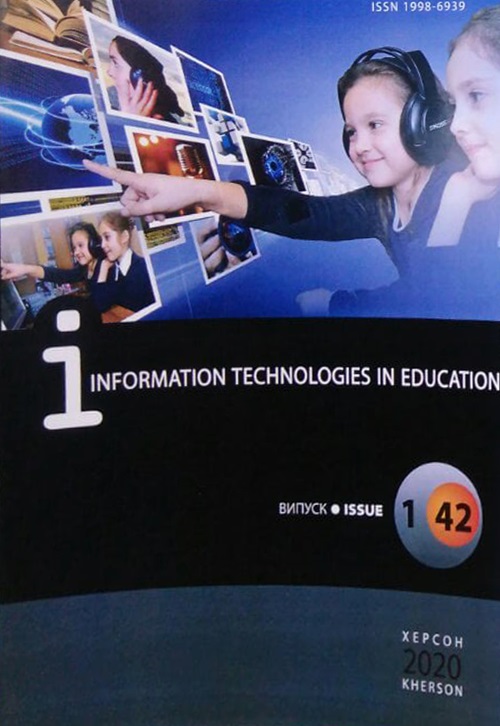INFORMATION AND COMMUNICATION TECHNOLOGIES AS TOOLS FOR IMPROVING STUDENTS’ MOTIVATION TO LEARNING
DOI:
https://doi.org/10.14308/ite000715Keywords:
use-ICT, teaching, electronic journal, e-learning resources, teacher-studentAbstract
The purpose of the study is to determine the effectiveness of the use of computer tools in the educational process, including electronic journals of student achievement in pedagogical and technical higher education institutions. The role of information and communication technologies in the life of the modern student. Influence of electronic tools on formation of consciousness of the future specialist in the chosen field. Conditions of application of modern technologies in educational establishments of Ukraine are investigated. During the experiment, questionnaires were applied (before and after the experiment), testing (before and after the experiment). The reliability of the Cronbach questionnaire was 0.87. 107 respondents from different Ukrainian educational institutions participated in the study. The survey established the level of motivation of students to get a higher education. The conditions of using modern technologies in Ukrainian educational establishments are determined. The effect of electronic journals on the quality of academic achievement of students of technical and pedagogical specialties was experimentally tested. Positive changes were identified, increasing students' interest in the course, using e-journals during the educational process. The results of the study emphasize that students who have access to the group's e-journal of success, monitor their results, have the opportunity to evaluate their own underperformance and increase their personal rating. Low level of students' motivation is determined. Factors that influence the teacher-student-teacher feedback have been identified. The conditions that contribute to improving the comfortable environment during the students' study are considered. The pedagogical experiment shows that electronic tools help to build lasting feedback in knowledge transfer, increase student productivity in learning. The study found that a considerable number of students receive higher education only to receive the so-called «crust», which in their opinion, in the future will allow to get a good position. It should be noted that students are becoming more aware of the latest technologies every year. A number of measures for organizing a comfortable environment for students' study in the modern dimension are highlighted.
Downloads
Metrics
References
2. Ekuobase G. O., Olutayo V. A. (2016). Study of Information and Communication Technology (ICT) maturity and value: The relationship. Egyptian Informatics Journal, 17, 239–249.
3. Kozma, R. (2011). A framework for ICT policies to transform education. In Transforming education: The power of ICT policies, 19-36. Paris: UNESCO.
4. Lucchetti, R., Sterlacchini, A. (2004). The Adoption of ICT among SMEs: Evidence from an Italian Survey. Small Business Economics 23, 151–168. https://doi.org/10.1023/B:SBEJ.0000027667.55821.53
5. MacKinnon, G. R., & Aylward, M. L. (2009). Models for building knowledge in a technology-rich setting: Teacher education. Canadian Journal of Learning and Technology, 35(1), 1-7.
6. Ojeda, F., Gutiérrez, J., & Perales, F. J. (2009). Qué herramientas proporcionan las Tecnologías de la Información y la Comunicación a la educación ambiental? [What tools do information and communication technologies provide for environmental education?] Revista Eureka sobre Enseñanza y Divulgación de las Ciencias [Eureka Journal on Science Education and Spreading], 6(3), 318-344.
7. Peansupap, V., & Walker, D.H.T. (2005). Exploratory factors influencing information and communication technology diffusion and adoption within Australian construction organizations: a micro analysis, Construction Innovation: Information, Process, Management, 5(3), 135-157.
8. Peansupap, V., & Walker, D.H.T. (2006). Information communication technology (ICT) implementation Constraints: A construction industry perspective. Engineering Construction and Architectural Management, Emerald, UK, 13(4), 364-379.
9. Pontes, A. (2012). Representación y comunicación del conocimiento con mapas conceptuales en la formación del profesorado de ciencia y tecnología [Knowledge representation and communication with concept maps in science and technology teacher training]. Revista Eureka sobre Enseñanza y Divulgación de las Ciencias Eureka [Journal on Science Education and Spreading], 9(1), 108-125.
10. Rautopuro, J., Pöntinen, S., & Kukkonen, J. (2006). Towards the Information Society - the Case of Finnnish Teacher Education. Informatics in Education, 5(2), 297-312.
11. Sang-Oun Lee, Ahreum Hong & Junseok Hwang (2017). ICT diffusion as a determinant of human progress, Information Technology for Development, 23:4, 687-705, DOI: 10.1080/02681102.2017.1383874
12. Tso, F. P., Jouet, S., & Pezaros, D. P. (2016). Network and server resource management strategies for data center infrastructures: A survey. Computer Networks, 106, 209- 225. doi:10.1016/j.comnet.2016.07.002)
13. Tay, L. Y., Lim, C. P., & Lim, S. K. (2015). Differences in ICT Usage Across Subject Areas: A Case of an Elementary School in Singapore. Journal of Educational Computing Research, 53(1) 75–94.
14. Timms, M., DeVelle, & S., Lay D. (2016). Towards a model of how learners process feedback: A deeper look at learning. Australian Journal of Education. 60(2), 128–145.
15. Жалдак М. І. Проблеми інформатизації навчального процесу в середніх і вищих навчальних закладах / М. І. Жалдак // Комп’ютер в школі та сім’ї. – № 3. – 2013. – С. 8–15.
16. Національна стратегія розвитку освіти в Україні на 2012–2021 роки [Електронний ресурс].– Режим доступу : http://guonkh.gov.ua/content/documents/16/1517/Attaches/4455.pdf
Downloads
Published
How to Cite
Issue
Section
License
This work is licensed under a Creative Commons Attribution-NonCommercial-ShareAlike 4.0 International License.






























